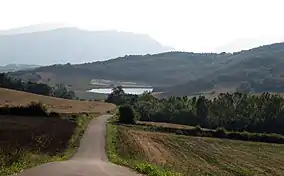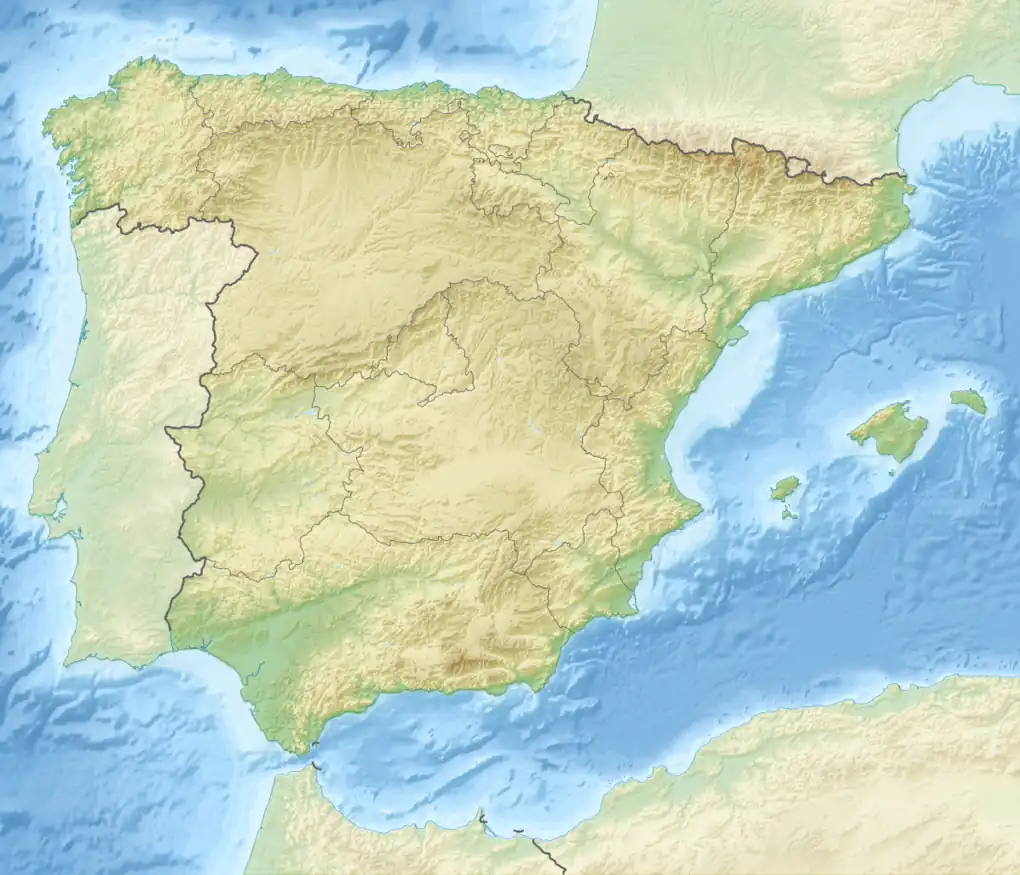| Añana Diapir Protected Biotope | |
|---|---|
| |
IUCN category V (protected landscape/seascape) | |
 Landscape in the area, with Lake Arreo visible in the background | |
.png.webp)  | |
| Location | Álava, Basque Country, Spain |
| Area | 14.81 km2 (5.72 sq mi) |
| Established | 31 May 2016 |
The Añana Diapir (Basque: Añanako diapiroa, Spanish: Diapiro de Añana) is a diapir in Álava, Basque Country, Spain. Two notable wetlands are located within the diapir: the Salt Valley of Añana and Lake Arreo. It was declared a protected biotope by the Basque Government in 2016.[1]
Geology
The Añana Diapir was formed by evaporites from the Keuper which ascended through Jurassic, Cretaceous and Tertiary layers. Other types of rocks were carried together with the evaporites, notably ophites. Clay, marl and gypsum are also present in the diapir.[2] The hydrogeological system of the diapir is complex. The saline water that flows through the Salt Valley results of the mixing of (at least) two types of water: superficial waters from the eastern part of the diapir and deeper waters from the western part (the ones which make the spring water saline).[3]
Flora and fauna
In the hypersaline waters of the Salt Valley, the only animals present are Artemia parthenogenetica and Ochthebius notabilis, with more species in areas of lower salinity. Lake Arreo is home to four fish species, and several bird species have been observed in its vicinity.[4][5]
About half of the diapir is covered by forests, consisting mostly of Pinus sylvestris and Quercus faginea.[2] Several hydrophytes are found in Lake Arreo, while its shores are covered by common reed and other plants.[6] Several halophilic plant species are present in the Salt Valley.[2]
References
- ↑ "DECRETO 85/2016, de 31 de mayo, por el que se designa el Lago de Caicedo Yuso y Arreo (ES2110007) Zona Especial de Conservación, y se declara el Biotopo Protegido del Diapiro de Añana" (PDF). BOPV (in Spanish) (159). 23 August 2016.
- 1 2 3 Diapiro de Añana (PDF). Euskal Mendizale Federazioa (Report) (in Spanish). Sistema de Información de Biodiversidad. pp. 6–9. Retrieved 11 October 2022.
- ↑ Zabaleta, A.; Azpiazu-Muniozguren, M.; Bikandi, J.; Uriarte, J.A.; Martínez-Ballesteros, I.; Garaizar, J.; Antigüedad, I. (2021). "Hydrobio-geology of the complex system of Añana diapir (Araba)" (PDF). Geo-Temas. Sociedad Geológica de España. 18: 331.
- ↑ "Censos de aves acuáticas nidificantes en la Comunidad Autónoma del País Vasco" (PDF). euskadi.eus (in Spanish). Basque Government. 2008. Retrieved 7 October 2022.
- ↑ Manzanos Arnaiz, Alberto (7 October 2011). "Estudio censal de las comunidades de peces en el Lago Arreo" (PDF). euskadi.eus (in Spanish). URA. Retrieved 12 October 2022.
- ↑ Documento de información ecológica, objetivos de conservación, normas para la conservación y programa de seguimiento para la designación de la Zona Especial de Conservación (ZEC) Lago de Arreo-Caicedo de Yuso (ES2110007) y del Biotopo Protegido del Diapiro de Añana (PDF). euskadi.eus (Report) (in Spanish). Dirección de Medio Natural y Planificación Ambiental. September 2015. Retrieved 12 October 2022.
External links
 Media related to Añana Diapir at Wikimedia Commons
Media related to Añana Diapir at Wikimedia Commons Geographic data related to Añana Diapir at OpenStreetMap
Geographic data related to Añana Diapir at OpenStreetMap